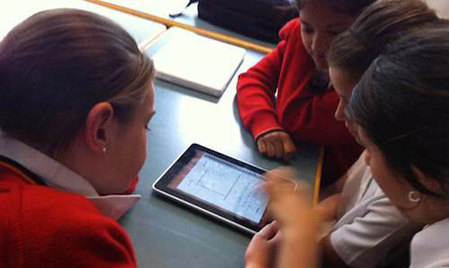美国德克萨斯州一个学区正尝试通过发放数千台iPad弥合学生间在数字领域的认知差距,这将是全美最大规模为学生提供iPad的计划。德州南部的麦卡伦独立学区本周开始发放6800个数码设备,绝大多数是iPad,年幼学生则是iPod Touch。预计明年这个时候,该计划将覆盖超过2.5万名幼儿园至中小学的学生,投资超过2000万美元,而另外一些学区也有效仿之意。将平板电脑用于教学,实属创新,也未见其效果。该学区负责人表示想通过这项计划改变课堂文化,将其变得更有吸引力、更具创新性,同时也向人们证明决定500美元买一台iPad2的投资是明智的。

|
 |
|
A Texas school district is trying to close its digital divide by distributing thousands of Apple tablet computers in a move that could make it the largest iPads program for students in the United States. |
McAllen Independent School District in the southern part of the state began distributing 6,800 devices this week - mostly the iPad tablet computers, but also hundreds of iPod Touch devices for its youngest students.
By this time next year, the district says every one of its more than 25,000 students from kindergarten to 12th grade will receive an iPad or iPod Touch. The district believes it's the largest to try for complete coverage and while Apple would not confirm that, other districts the company noted as having made large investments have not made ones as big as McAllen's.
Educational use of the tablet computers is so new that there's little evidence available on their impact. Superintendent James Ponce said the district wanted to change the classroom culture, making it more interactive and creative and decided Apple's devices - even at $500 retail for an iPad2 - were the best investment.
The district's typical classroom is outfitted with three computers for students and one for the teacher. Going forward those technology investments will be supplanted by the iPads. For now, McAllen's iPads don't carry its textbooks, but eventually they will and at much lower cost than the hard copies that can cost $200 apiece.
A small group of teachers in the district began preparing more than a year ago on incorporating the devices into their lessons. Recently, more instructors have started studying the devices. Teachers already training will see their students receive the first wave of devices.
About two-thirds of McAllen students were characterized as economically disadvantaged in 2010, the most recent data available according to the district. The median household income in McAllen, a city on the US-Mexico border near the southern tip of Texas, was about $41,000 in 2010.
School board President Sam Saldivar said the $20.5 million investment in the technology aims at "equity."
"We know that when they do achieve and are successful they are going to be generationally impacting their families and this community," Saldivar said.
Stacey Banks, a social studies teacher at McAllen Memorial High School, helped the district shape its program. She said textbooks for her class were 12 years old and she hadn't used them in the past five years, choosing to cobble together her own lessons instead with hopes of collaborating with colleagues to build electronic textbooks.
"It's given us a great opportunity to hone our skills as teachers and change our paradigm a little bit about what our classrooms look like and how we approach learning," Banks said of the iPads program. "That excitement has definitely migrated to the kids."
Sophomores in her class pulled up art images on Monday on their iPads. Banks asked them to find out how changes taking place during the Renaissance were demonstrated in art from the period.
"It's actually a really good technology," said 15-year-old Christian Hernandez, gently polishing the screen with the cuff of his sweatshirt.
He had never used an iPad before last week when he and other students got a sneak preview. After spending some time with it over the weekend, Hernandez was using the note-taking application and others with ease.
The district installed tracking software on the iPads so they won't go missing and their Internet connections will still be through the school district's filter, meaning students won't be able to access any sites that they'd be restricted from in school. Parents have to pay a $40 refundable deposit in two payments and can receive help with paying.
Zeeland Public Schools in Michigan gave 1,800 iPads to all of its high school students last fall and hopes to eventually cover every student in grades 3-12. Chicago Public Schools bought about 10,000 iPads and some individual schools in the district have bought more using discretionary funds, but it's far from districtwide.
相关阅读
(Agencies)

(英语点津 Rosy 编辑)